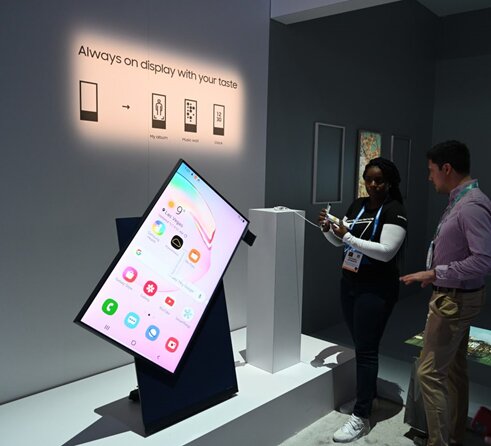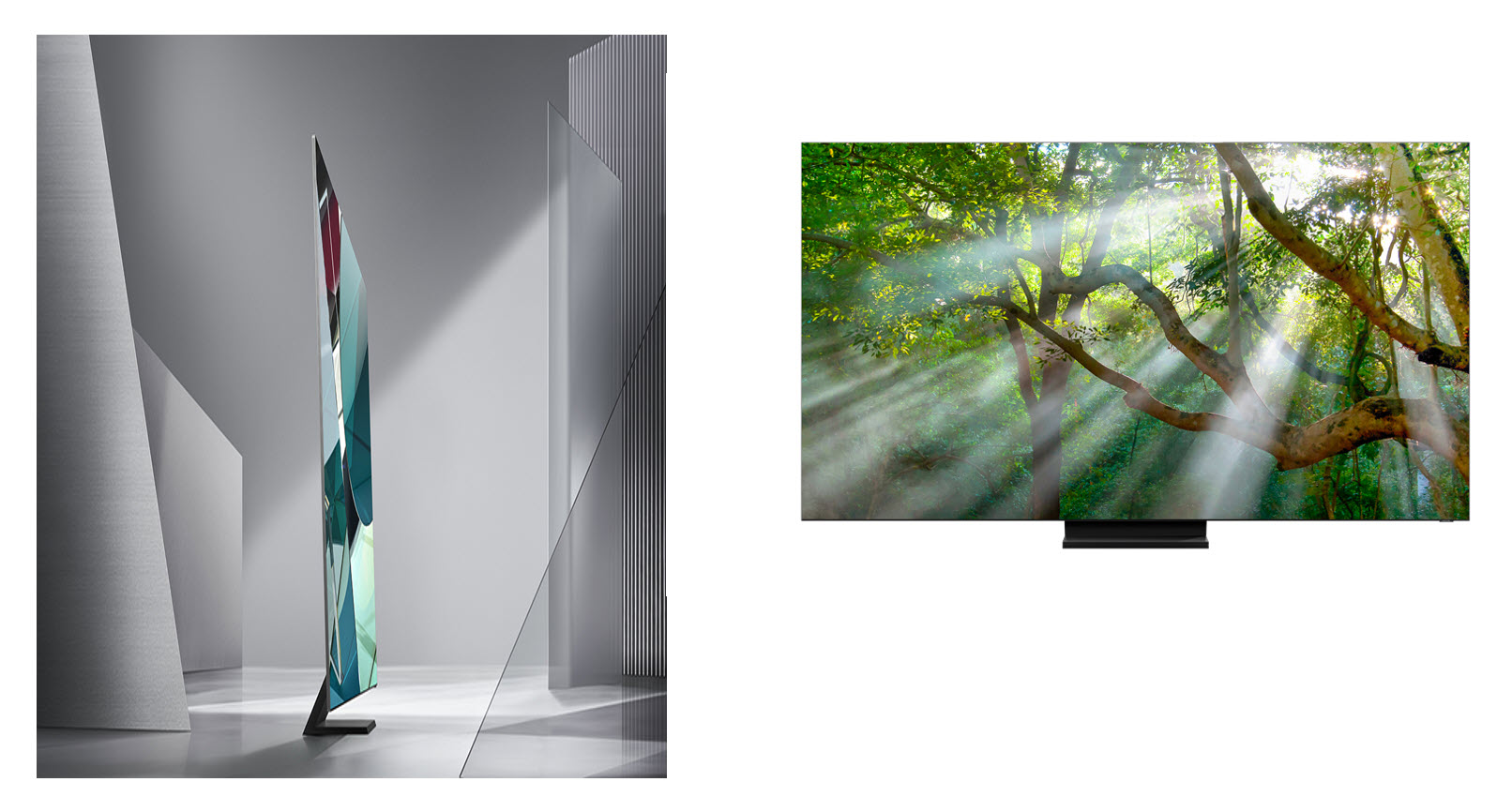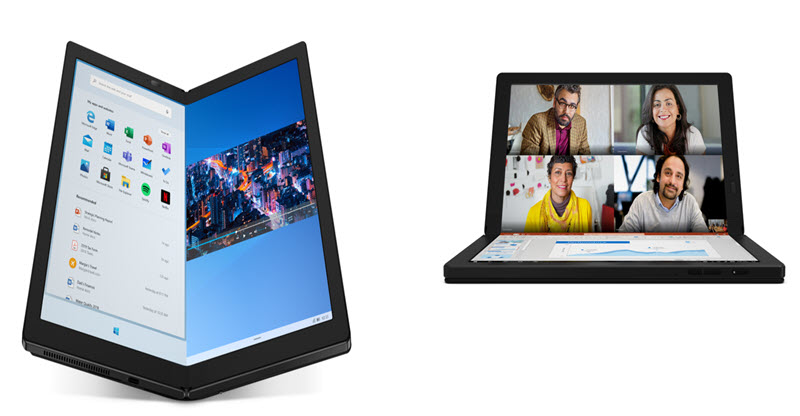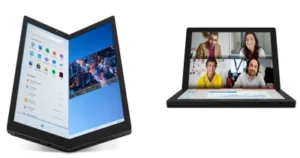Technology breakthroughs in the display industry have been enabling innovative consumer products. This year’s CES conference showcased many examples of this as products based on MicroLED, QLED, OLED and MiniLED dazzled attendees with their image quality, performance and designs.

MicroLED: Progressing in Size
Samsung impressed the attendees with their biggest TV ever with a 292-inch 8K TV based on MicroLED technology. The modular TV will be available in many different sizes (75, 88, 93, 110, 150) and the modules can be combined for different shapes, some with slim and bezel-less designs. LGE showed a 145-inch TV while Chinese brand, Konka, showcased a 236-inch 8K MicroLED TV. Samsung is planning to go into MicroLED TVs production soon. Still, at the moment, extremely high price and manufacturing challenges will lead to very limited shipments.
MicroLED is a self-emitting display, which consists of arrays of microscopic LEDs each forming a pixel. It is simple in structure but has a complex manufacturing process. It has the potential to create thinner, brighter, lighter, higher contrast and low power displays, but products are not yet commercialized or in mass production. MicroLED displays can be used for TV as well as for applications such as wearable devices, AR/VR headsets, automotive, smartphone and others.
In smaller sizes, AUO showed a 12-1-inch TFT driven full color MicroLED auto display; ITRI showed a display where the sensor functions are integrated into pixel; Plessey showed a monolithic 1080P MicroLED based near-eye display solution for AR/MR, and Jade Bird Display showed MicroLEDs for AR/VR with extremely high brightness (up to 3 million nits).
Many companies are working to resolve manufacturing, yield and costs issues to enable volume productions for consumer products. There are still many challenges to be solved which will take a few more years to overcome.
QLED: New Products, New Designs
Samsung unveiled its very impressive flagship Q950TS QLED 8K TV which has
- an ultra thin form factor (only 15mm even with full array local dimming (FALD) backlight),
- an “infinity screen” (very thin bezel that produced 99% body to screen ratio),
- built in 8K AI up-scaling capabilities, and AI quantum processor.
Samsung is trying to position these TVs as the central hub for connected living with AI, voice assistance and many other features. The company is also trying to increase adoption of 8K by bringing it to many sizes and price points. Samsung also showed a unique design with its “Sero”, 43-inch 4KQLED TV that can shift from landscape to portrait mode like a smartphone.

Besides Samsung, Vizio (a new 85-inch FALD and a series of other models), Hisense (expanded QD TV line up), Konka (the company’s QD TV for U.S) and others also demonstrated Quantum Dot TVs at CES, most coming in 2020. TCL pushed the quantum dot technology performance even further by combining it with a miniLED backlight. According to TCL, by infusing micro-metre class MiniLEDs directly into a glass substrate, its Vidrian 8K TV is able to achieve stunning contrast, brilliant luminance, enhanced color and stable long life performance.
 Samsung QLED Q950 – Click for higher resolution
Samsung QLED Q950 – Click for higher resolution
Quantum dot saw expansion in the gaming monitor side with Acer and Asus showing the latest versions of their QD MiniLED display technology with 1152 local dimming zone on 4K G-Sync monitors significantly improving picture quality and reaching 90% BT 2020 color gamut with Nanosys’ Quantum dot technology. QD displays will be entering an expansion phase in 2020 with lower prices, more brand availability of TVs in many sizes and price points and expansion into monitors and notebooks. During Black Friday sales, Samsung’s QLED TV reached $499 for 43-inch and $999 for the 55-inch size. TCL’s 65-inch QLED TV was available in Costco for $599. Lower retail prices for QD TVs will drive demand.
OLED-Flexible, Rollable, Foldable
At CES 2020 LGE showed 65 RX, its rollable OLED TV that can roll up from a box. It is expected to ship in 2020. The industry buzz is that it will be very expensive around $60K. LG Display showcased a concept of a very impressive rollable TV that can roll down from ceiling. Th flexibility of OLED display technology has enabled many innovative consumer products in recent years and more will be coming.
To showcase its newest processor ‘Tiger Lake”, Intel unveiled the largest foldable PC, codenamed “Horseshoe Bend”. It is a 17.3-inch OLED device that folds like a laptop but opens up to be a 17.3-inch desktop monitor. Lenovo launched its foldable PC Thinkpad X1 fold (only 2.2 pounds) with a 13.3-inch OLED display. The display can be seen in full screen, one-screen plus keyboard mode or dual screen mode and folds into an ultraportable size. Dell showed ‘ORI” a large folding tablet that can close like a book (availability mid 2020). Samsung demonstrated a Galaxy Chrome 2-in-1 laptop with a high performance 4K OLED.
 Lenovo’s X1 foldable
Lenovo’s X1 foldable
Foldable smartphones, enabled by flexible foldable OLEDs, started entering the market at the end of 2018 with Royole’s Flexpai. Samsung, Royole and Huawei already have first generation foldable smartphones on the market in the $1300 to $2600 range. Higher prices along with reliability and design issues have resulted in limited shipments in 2019. Starting from 2020, foldable smartphones will be shifting more towards a new clamshell design away from the folding book type. Most of the smartphone announcements will happen at MWC (mobile world conference in February). TCL showcased a working prototype of a foldable phone with 5G at CES 2020 and announced a 5G smartphone at “less than $500” this year.
LG Display showed a first class airplane cabin concept using a transparent OLED, that can also works as a privacy screen, and a 65-inch bendable OLED TV for an immersive experience. LGD also showed a flexible rollable plastic OLED for passenger seat entertainment that can roll up and down and disappear behind the seat.
Many companies showcased autonomous car concepts where they used bended curved display extensively. Royole showed an Amazon Alexa-enabled speaker with its 8-inch fully flexible wrap around OLED.
OLED TV has secured a strong presence in the premium TV market. The introduction of 48-inch OLED TV will help the technology meet lower price-point needs. Brands such as LGE (48-inch to 88-inch, 4K, 8K, wall TV, gaming TV G-SYNC capable), Sony (>=48, 4K,8K), Panasonic (brighter higher performance display), Vizio (first time OLED TV), Hisense and Konka all showcased various sizes and types of OLED TV. LG Display is the only supplier for OLED TV panel, leading to limited supply. LGD is converting LCD TV capacity to OLED and is also investing an additional 3 trillion KRW into a Gen 10.5 OLED production line, mainly producing >=65-inch TV panels. It is planning to almost double the TV panel production in 2020.
LCD: Reinvention with MiniLED, Dual-cell, QD
Hisense showcased a dual-cell LCD TV scheduled to arrive in the second half of 2020 (the concept was first introduced in 2019). Hisense XD9G TV uses two LCD modules for better viewing angles, higher contrast ratiso and deeper black levels than traditional LCD TV. Interestingly AUO showed a 12.3-inch Auto dual cell LCD pixel dimming curved display with true black level and a contrast ratio of over 100,000:1.
AUO also showed an 85-inch 8K bezel-less ALCD TV with advanced HDR, 1000 dimming zones. It also had a MiniLED based gaming display with 144Hz refresh rates and 2500 cd/m² peak brightness. Sharp showed the largest class 120-inch 4K and 8K LCD TVs. Vizio unveiled a MiniLED backlight-based 8K LCD TV. On the cover of 13.3-inch Thinkbook Plus, Lenovo used a secondary 10.8-inch E Ink display for notification and note taking. Many suppliers showed products based on MiniLED backlight that can enable LCD re-invention.
MiniLED backlight displays can offer higher contrast ratio, higher brightness, deeper black, and better power consumption. TCL was the first to introduce a MiniLED backlight-based QD TV in 65-inch (<$2000) and 75-inch( <$3000) in 2019. The products have received very positive reviews. MiniLED-based products are already being shipped for high-end monitor and notebook applications. MiniLED costs have gone down recently due to increased efficiency and lower chip costs. It still faces cost challenges to become competitive. In the near term, suppliers are focusing more on value-based applications such as TV, gaming, automotive and VR.
Technology breakthroughs in MicroLED, Quantum Dot, OLED and MiniLED backlight technology have enabled consumer products with larger screen sizes, higher brightness, better contrast, higher color gamut, lower weight and many unique designs which were showcased at CES 2020 pushing the envelope of next generation display products. (SD)
Sweta Dash is the founding president of Dash-Insights, a market research and consulting company specializing in the display industry. For more information, contact [email protected] or visit www.dash-insight.com

